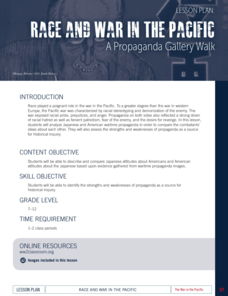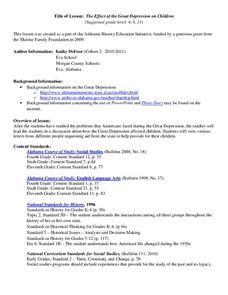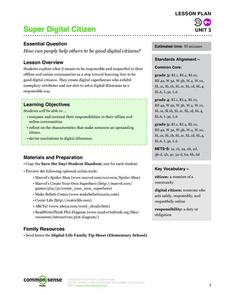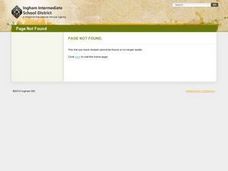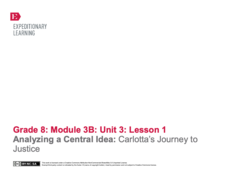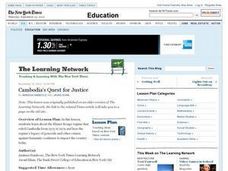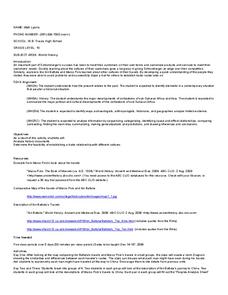Teaching Tolerance
Using Photographs to Teach Social Justice | Exploring Identity
Even without captions, photographs can tell amazing, involved, and complex stories. Viewers analyze two photos, consider what the pictures reveal about the subjects' identity, and determine the social justice issues represented in the...
Alabama Department of Archives and History
Inside the Wire: Internment of Prisoners of War in Alabama during World War II
Create an open environment of discussion and collaboration with several exercises in a thought-provoking resource. Pupils conduct a gallery walk and lead a discussion before filling out a question sheet and chart during the learning...
Encyclopedia Britannica
Political Issue Timeline
As part of a study of US Presidential elections, class members track the history of an issue in the 2020 campaign. They create a timeline to determine if there are any patterns, if ideas about the issue have evolved, or if in issue is no...
National WWII Museum
Race and War in the Pacific: A Propaganda Gallery Walk
Race played a key role in the war in the Pacific during World War II. Using images from both American and Japanese sources, learners consider racial propaganda and how leaders used it to rally popular support during the conflict. After...
Alabama Department of Archives and History
The Effect of the Great Depression on Children
How did the Great Depression affect children? Sometimes studying the Great Depression means only studying about how it affected adults, however, relating the experiences of children and peers their age to themselves may make the...
Daughters of the American Revolution
Lesson 1: How Do Society’s Expectations Influence Education?
The history of women's education can be traced back to the delicate stitching of student samplers from the 19th century. Modern-day pupils examine and analyze four primary sources, three of which are images of embroidered samplers, which...
Encyclopedia Britannica
Campaign Photo Analysis
It's the art of the image! As part of a study of the 2020 Presidential race, groups analyze an image of a candidate, first from an objective point of view and then subjectively. They then prepare a presentation detailing what they...
Curated OER
Financial Institution Comparison
Once learners are ready to choose a bank, how do they make a smart decision for their financial needs? Scholars help each other by jigsawing the research in groups. After introducing checking and savings accounts with the attached...
Common Sense Media
Super Digital Citizen
Teach your charges how to become responsible digital citizens with superheroes! Start out with a brief class discussion about what acting safely, responsibly, and respectfully looks like. Next, have each pupil create their own digital...
National Woman's History Museum
Defying British Rule: Women's Contributions to The American Revolution
Primary and secondary sources are the focus of a lesson that showcases the important role women played during the American Revolution. Pairs review sources and discuss their findings. A close-reading of an informational text leads the...
Curated OER
A Visual History: Industry, Society, and Social Mobility in Hartford
Eleventh graders examine the industrialization of Hartford. In this American History lesson, 11th graders analyze pictures in Hartford. Students participate in a gallery walk of artifacts.
Curated OER
Gallery Walk/Webquest
Students participate in a gallery walk or Web Quest to study the various roles and processes in the Canadian government.
Pace University
Urban Communities
Urban communities are the focus of a series of lessons created to meet specific needs using differentiated instruction. A pre-assessment designates scholars into three groups based on their ability level. Small groups take part in...
US Institute of Peace
Defining Conflict
Before there can be peace, we have to understand conflict. Introduce the concept of conflict through a two-part activity that combines discussion, collaboration, and writing. The first in a 15-part series examines the multiple meanings...
Facing History and Ourselves
Citizen Power Makes Democracy Work
Eric Liu's formula "power plus character equals citizenship" and his three strategies to making change happen model for high schoolers how to develop citizen power, how to get involved and participate to make democracy work. Class...
Curated OER
Lesson: Lisa Signal: Altering Perspectives
Kids make big artistic gestures, just like the abstract artist, Lisa Signal. They use her work as inspiration for making simplistic, abstract, statements in an artistic way. They analyze her work, then walk through an unfamiliar...
Curated OER
Striking Out Stress- A "Gallery Walk" Activity
Students discuss ways to cope with stressful situations. In this mental health lesson, students identify stressful situations and how they would respond to them. Students discuss their feelings.
Curated OER
Portraits of History
Eighth graders research the Post-Revolution to Pre-Civil War era by investigating the life and contributions of a notable person. They create silhouettes which are framed with timeline. Also, they add the research information to the...
iCivics
Propaganda: What’s the Message?
As class members progress through eight fully prepared learning stations, they will identify how bias is present in persuasive media, as well as differentiate among types of propaganda techniques like bandwagon propaganda and the...
Curated OER
Colonial New York Slave Codes: Law and Order
Build a historical perspective from four different points of view. Young historians take on the role of a slave-owning white person, non-slave owning white person, slave, or free African-American person and imagine what life would be...
EngageNY
Analyzing a Central Idea: Carlotta’s Journey to Justice
Verbs are deceptive and like to disguise themselves. Young linguists identify verbals, specifically gerunds, infinitives, and participles when analyzing the third stage of Carlotta's journey in the novel A Mighty Long Way. Bridge...
Curated OER
Cambodia's Quest for Justice
Learners observe pictures, articles, maps, charts and other gathered information concerning the Khmer Rouge regime that ruled Cambodia by participating in a gallery walk. Afterward, they discuss war crimes and the significance of...
Curated OER
Medieval Travelers
Tenth graders explore the impact of trade on culture. In this trade lesson plan, 10th graders compare the travels of Marco Polo and Ibn Battuta. Students research the explorers and create materials for a gallery walk that feature the...
Curated OER
Who Were the Ottomans?
Learners explore the Ottoman Empire. In this Ottoman Empire lesson, students analyze images of the empire as they take a gallery walk. Learners compare and contrast the Ottoman Empire to the other empires in the region of modern-day Turkey.



